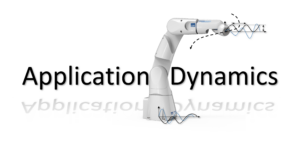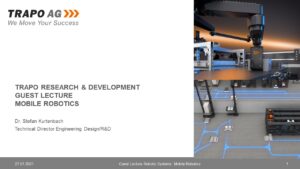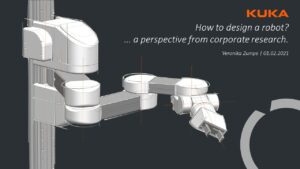Kategorie: ‘Roboterprogrammierung’
FunkDAF: Multidimensional additive manufacturing
At the IGMR, we are working on the next generation of additive manufacturing as part of the DFG-funded FunkDAF research project together with the MSE and VCI institutes: layerless, multidimensional material deposition.
🔹 What does that mean?
Multiaxial additive manufacturing with a robot-guided print bed allows us to deposit material along specific stress paths. This leads to improved material utilization and reduces the disadvantages of layer-by-layer construction.
🔹 Our challenges:
– Precise robot guidance along the print paths
– Synchronization of extruder and robot movement
– Constant printing speed for maximum quality
The print paths are generated on the VCI from FEM stress data – resulting in mechanically optimized structures. 💡
Contact person:
Mark Witte – witte@igmr.rwth-aachen.de
Automated robotic dismantling/disassembly – screw detection and removal for electric vehicle recycling
Fully automatic disassembly with precision!
Our new robotic system is revolutionizing the disassembly of electric car batteries. Using the Neura Lara 8 robot and the latest image processing technologies, we recognize screws fully automatically and position the robot precisely to remove them safely.
Thanks to the integration of YOLOv8 and Intel RealSense depth cameras, the system can locate screws in real time and position them optimally on its own. No manual intervention necessary – the system works completely autonomously!
Our goal: to make the recycling process safer, faster and more efficient. Fewer risks for workers and maximizing the recovery of raw materials at the same time. This is the future of the circular economy!
You can find more information about #dimonta here.
contact:
Markus Schmitz
Daniel Gossen
3D Capsule Compliant Grippers
At the ASME IDETC-CIE conference in Washington, DC, we had the opportunity to present the prototype of the “3D Capsule Compliant Gripper”. This novel surgical manipulation tool was specifically designed to make lymph node isolation even more precise and gentle.
Our approach: a capsule-like structure with flexible, shape-optimized elements that have been tailored using a hill-climbing mutation algorithm. The white “petals” of the prototype were 3D printed from PLA, the red flexible components from TPU. Thanks to the cost-effective production at our institute, we were able to create the first efficient solution on a macro scale, which serves as a proof of concept.
Contact: Estefania Hermoza Llanos
Semi-Automated Tile-Laying Aid
Der an dieser Stelle eingebundene Inhalt führt Sie auf Seiten, die von der von Google betriebenen Seite YouTube - YouTube, LLC, 901 Cherry Ave., San Bruno, CA 94066, USA - zur Verfügung gestellt werden. Mit dem Aufruf des Inhalts kann YouTube Ihre IP-Adresse und die Sprache des Systems, sowie verschiedene browserspezifische Angaben ermitteln. Wenn Sie in Ihrem YouTube-Account eingeloggt sind, ermöglichen Sie YouTube, Ihr Surfverhalten direkt Ihrem persönlichen Profil zuzuordnen. Dies können Sie verhindern, indem Sie sich aus Ihrem YouTube-Account ausloggen. YouTube verwendet Cookies und Tracking-Tools. Die Datenverarbeitungsvorgänge sowie die Zwecke der Verarbeitung können direkt bei YouTube erfragt und eingesehen werden.
As part of the ErgoFli project, an innovative system is being developed in collaboration with project partners to help tile layers make their work more ergonomic and efficient.
In the video you can see how the system works in the Gazebo simulation environment. The robot automatically removes tiles from a magazine and matches them perfectly to the tiles already laid. With automatic processes, several tiles can be laid in succession to optimize the work process.
Our aim is to create a tool that not only reduces the workload for tilers, but also improves their working environment. We are excited about the progress and look forward to sharing more insights with you soon!
Find out more about the project here.
Contact person:
Mark Witte
Jan Wiartalla
First movement of PARAGRIP with new control unit
PARAGRIP’s control architecture has been completely redesigned in order to be fully equipped for its future tasks in multidirectional additive manufacturing (MDAM) with arc welding (WAAM). The movements of all four arms can now be planned, simulated and executed on the real robot using MoveIt in ROS2. The joint positions of the physical robot are always fed back to ROS2, allowing the integration of online planning algorithms in the future. The video shows the planning and execution of a simple test motion of the PARAGRIP.
More information about the project can be found here.
Contact: Jan Wiartalla
A multi-layered task sequencing approach
Cobots are highly sought by manufacturing companies in contrast to fully automated production lines, as they provide the additional benefit of flexible operations. A major hurdle with current collaborative setups is tedious setup times for efficient and robust co-working as well as poor support for random interruptions.
This project focuses on enabling autonomous collaborative operations for serial manipulators where interruptions from human agents occur at random while ensuring minimal setup times. To this end, two primary aspects that impact task execution are addressed, namely execution time and co-working as enumerated below:
- A method is developed to minimise the total distance travelled, by following the most optimal sequence for the given task while retaining online operational capabilities
- A real-time replanning and co-working algorithm for randomly interruptive environments is developed and implemented to ensure continued operation even when regions of the workspace are occluded while guaranteeing safety of the human agents in the workspace. The co-working controller operates fully autonomously.
An example of the working of the deployed on a prototype platform consisting of a collaborative UR10e arm, a stereo camera for static environment mapping and a laser scanner for mapping of dynamic obstacles is shown in the video.
Contact: Daniel Gossen
music: madiRFAN – Both of Us (https://pixabay.com/music/beats-madirfan-both-of-us-14037/)
Watch the video on our Youtube channel: here.
IGMR Seminar 08.02.2021 14:30 Uhr: Dr. Stefan Kurtenbach, Trapo AG
Wir begrüßen Dr. Stefan Kurtenbach von der Trapo AG zum IGMR Seminar. Auch diese Veranstaltung wird weiterhin virtuell durchgeführt:
Der Vortrag von Dr. Kurtenbach wird einen Eindruck der aktuellen Entwicklungen und Produkte von der Trapo AG geben.
Trapo Research and Development: Mobile Robotics
Montag, 08. Februar 2021 14:30 Uhr
Zoom Meeting Informationen:
https://rwth.zoom.us/j/98454895570?pwd=NkpiSWkyaTJtdWlralJrSUtnMDdDZz09
Meeting-ID: 984 5489 5570
Kenncode: 186393
Die Datenschutzhinweise zur Nutzung von Zoom und eine Handreichung für Teilnehmer (Studierende) können von den Seiten des CLS der RWTH Aachen University heruntergeladen werden.
Die Veranstaltungen im Wintersemester 2020/2021 werden in Zusammenarbeit mit dem VDI-GPP-Arbeitskreis des Bezirksvereins Aachen durchgeführt.
Weitere Informationen zum Thema können den folgenden Blogeinträgen entnommen werden:
Industrieprojekt Trapo Loading System
Ansprechpartner:
IGMR Seminar 01. Februar 2021 14:30 Uhr: Veronika Zumpe, Kuka AG
Wir begrüßen Frau Veronika Zumpe von Kuka zum IGMR Seminar. Auch dieser Veranstaltung wird weiterhin virtuell durchgeführt:
How to design a robot. A perspective from corporate research.
For specific handling tasks, there is a need for the development of new robotic systems. It is necessary to develop and design the system with respect to the given task, environment and other constraints. The design process includes finding a suitable kinematic, developing drive concepts for the robot axes, designing the structural parts and finalizing the robot design. For applications with human robot collaboration, more aspects like lightweight design play a significant role and thus should be taken into account. This talk gives a rough overview of the design process of a robot from my corporate research perspective.
Montag, 01. Februar 2021 14:30 Uhr in Zoom
https://rwth.zoom.us/j/98454895570?pwd=NkpiSWkyaTJtdWlralJrSUtnMDdDZz09
Meeting-ID: 984 5489 5570
Kenncode: 186393
Die Datenschutzhinweise zur Nutzung von Zoom und eine Handreichung für Teilnehmer (Studierende) können von den Seiten des CLS der RWTH Aachen University heruntergeladen werden.
Die Veranstaltungen im Wintersemester 2020/2021 werden in Zusammenarbeit mit dem VDI-GPP-Arbeitskreis des Bezirksvereins Aachen durchgeführt.
Ansprechpartner:






